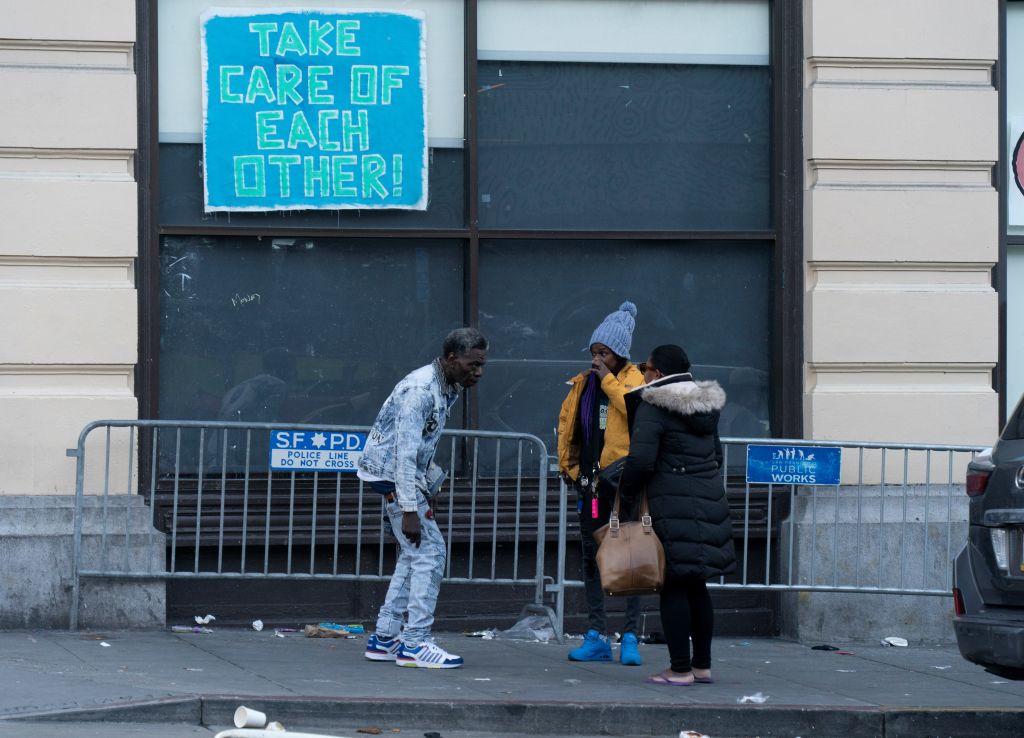When I wandered the streets of Washington more than 30 years ago to learn what services homeless men could receive, I found two kinds of institutions, each with drawbacks. The Community for Creative Non-Violence at the corner of Second and D streets in Washington, D.C. —1,350 beds, the most of any shelter in the United States—had no barriers to entry. It had a street reputation as a place where drug use was rampant and, ironically, so was violence. The Gospel Mission a few blocks away was a traditional Christian organization that offered dinner and a safe bed, but it had a string attached: required attendance at an evening worship service.
Over the years I visited other Christian shelters in California and Colorado, Texas and Missouri, and Illinois and Pennsylvania, and saw some fairly low common denominators. Hymn singing at rescue mission services was louder and lustier than what I’m used to as a Presbyterian elder, but that’s because many of the participants were drunk. I volunteered alongside a Miss America at a New York City mission, but except for her all the shelters were old and mostly ugly.
The picture around the country now is generally darker but with new points of light. On the negative side, the Department of Housing and Urban Development last month released its “Annual Homelessness Assessment Report” and reported the highest numbers since national counting began in 2007. Last year 653,100 people (up 12 percent since 2022) were without a home on one particular night, which probably translates into 2 million homeless at various times during the year. Last year also brought large increases in the number of homeless single moms with children and the number of under-25 persons without homes.
During the past few months, though, I’ve visited some newer Christian shelters and have lived for two weeks in three of them. None requires residents to sing for their suppers, with feeding dependent on chapel attendance. Most of the buildings are new or freshly painted. The freshly plastered still gain admittance, but the programs are hugely varied. Here are three examples of the variety, on a spectrum ranging from purpose-directed (where residents must follow a specific schedule throughout the day) to largely libertarian (where residents have almost no requirements).
Tustin, California.
Thirty years ago the Orange County Rescue Mission (OCRM) inhabited old buildings in Santa Ana. Fifteen years later OCRM opened its campus, 36 miles south of Skid Row in Los Angeles, on the site of what had been a Marine Corps base. Now, new buildings include an airy dining hall and a chapel/auditorium with modern stained-glass windows alongside a bright playground and petting zoo for children.
OCRM calls its 340 residents “students” and organizes them in four classes. Freshmen—students in the first 3-5 months of what is typically an 18-month program—go through assessments of physical and mental health, educational and legal status, computer skills and financial understanding. They participate in therapy groups, work through three Bible study books, and wear yellow lanyards. They’re busy all day and are not allowed to leave the OCRM grounds.
Sophomores (wearing green lanyards) and juniors (blue lanyards) have some liberty but still stay busy completing three more “Design for Discipleship” books, working in various campus jobs, obtaining a high school diploma if they don’t have one, and taking a “Road to Success” course. Seniors wear red lanyards and begin outside employment.
Safety first: OCRM has 600 cameras recording what happens in every public area and corridor. Yet OCRM respects personal autonomy in that anyone in its program can leave the mission at any time—but those who stay have to turn over all their cellphones and other electronic devices. They get them back near the end of their program, or when they drop out. Students aren’t allowed anything containing alcohol, including mouthwash and perfume.
I interviewed 40 students, almost all under 40, during my four days of living at OCRM. Commonalities included anarchic childhoods: jumping from foster care home to home, running circles around a beleaguered single parent, living for drugs and alcohol. Most of them seemed ready to escape from a careening life and gain some discipline that could turn into self-discipline.
Springfield, Missouri.
At the other end of the spectrum is Eden Village. It sits in one of Springfield’s gray industrial areas, but inside its gate I felt like a walk-on in The Wizard of Oz when it moves from black-and-white to color. On both sides of a paved one-eighth of a mile sit 31 craftsman-style, 390-square-foot homes of all different colors.
The major Eden rules are few: Pay $325 per month rent (usually from government disability payments). Don’t consume anything illegal—alcohol and marijuana (now legal in Missouri) are allowed in private places. Don’t fight with neighbors. And Eden Village is meeting-minimalist. A community room was empty 90 percent of the time during my six-day stay.
Staff members are Christians, and some Bible-related phrases are visible on walls and plaques: “My God will supply all your needs according to His riches in glory in Christ Jesus.” Several residents attend a coffee hour once a week that gives room for group prayer and a church brings dinner once a month.
I interviewed 23 of the residents during my six days of life in Eden. Around the fourth day some of them began leveling with me, and I didn’t see much interest in exploring Christianity. Only a handful of the residents go to church.
Nate and Kelbi Schlueter manage Eden and say that God—not activity—changes people. “I’m skeptical about what ‘programs’ can achieve,” Nate said, and Kelbi deliberately avoids soliciting churches to bring meals. Formerly homeless people need to “learn to live independently … depending on others for food can foster ungratefulness and entitlement,” she said.
Colorado Springs, Colorado.
Springs Rescue Mission, a tiered program with 450 beds, is in the middle of the spectrum. It has a welcome sign out 24/7, 365 days a year and encompasses three different living situations. The starting point is its Relief Shelter: Anyone who enters gets a storage bin, a warm bed in a big open area, and a cold breakfast. It’s “low barrier” but not “no barrier,” because it does have rules as explained by CEO Jack Briggs: “Don’t fight. Don’t call the staff names. You can’t use or sell [drugs] while you’re here.”
Then come incentives to move to the Next Step Shelter, where each step increases momentum: Same bed every night, eggs-and-bacon hot breakfast, a locker the resident can go to any time. Residents get physical, mental, and behavioral health checkups. They can get their IDs and address legal issues. Do more, get more. Springs offers vocational training in custodial and maintenance trades and culinary arts, starting with the basics: showing up on time, being clean, doing what you’re asked.
Springs does not hide its Christian core, but it also does not obligate those staying for a night to attend a Christian service. “Our faith is why we do what we do, but faith is never required of others to receive basic relief services,” Joel Siebersma, senior director of transformation and research at Springs Rescue Mission, said. “Yes, we hold them accountable, but … it’s God’s job to change people. It’s our role to help in the project, not own it.”
After Next Step, residents can move into the Advanced Shelter Program, with better accommodations. Addicts who want to change can enter an intensive one-year New Life Program. Doctors, counselors, and psychiatrists offer physical and mental help. Bible studies and church services offer spiritual help.
It’s always a step at a time. Residents in the culinary arts program start by washing dishes. After they show they can be on time and do a job, they learn to prepare meals, starting with simple ones, and can earn ServSafe licenses that lead to culinary jobs. Springs has a liaison who visits potential employers and explains how a former meth addict could be someone the business wants to hire. Employers have learned to trust those whom Springs recommends.
CEO Briggs, a former Air Force major general, introduces himself to people walking into his mission off the streets: “I’m Jack. What’s your name?” Sharing a name created a bond, he explains. Many homeless people “live in a world where no one keeps a promise,” so residents at Springs hand over clothes to be washed— and they get them back. Everything at Springs, Briggs says, is designed to build trust.
The varieties of Christian shelter experience.
Which is best: strict, loose, or middling?
The different groups serve different demographics: Most Eden Village residents, because of age or mental disabilities, are not in the job market. The average age is 56, and most residents are looking not for a way-station but a final destination. At OCRM and at Springs, most are young and will head out when they complete the program.
Homelessness is complex and outcomes are hard to predict, so we’ll know better in a few years which programs work best. But the late Pastor Tim Keller’s summary of the Gospel is worth remembering: “We are more sinful and flawed in ourselves than we ever dared believe, yet at the very same time we are more loved and accepted in Jesus Christ than we ever dared hope.”
Some programs emphasize sin, some emphasize love, and the balance is sometimes hard to find. Demanding that residents change may seem cruel, but removing incentives to be open to change is also cruel. Most of the several hundred homeless persons I’ve talked with lived in a small world of day-to-day survival, with a god who was often much too small. These days I like seeing a variety of groups following different strategies, rather than pretending—as is common in our polarized society—that one size fits all and one particular approach is proven best.






Please note that we at The Dispatch hold ourselves, our work, and our commenters to a higher standard than other places on the internet. We welcome comments that foster genuine debate or discussion—including comments critical of us or our work—but responses that include ad hominem attacks on fellow Dispatch members or are intended to stoke fear and anger may be moderated.
With your membership, you only have the ability to comment on The Morning Dispatch articles. Consider upgrading to join the conversation everywhere.